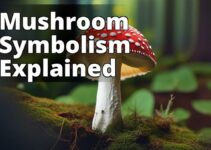Are you curious about the traditional use of Amanita Muscaria in herbalism? This article will provide information on the traditional and modern uses of Amanita Muscaria, as well as its preparation, use, and safety.
About the Author
Before we dive into the topic, it's important to know that the author of this article is a qualified and experienced herbalist. The author has extensive knowledge of traditional herbalism and modern research on herbal medicine.
Amanita Muscaria Traditional Use in Herbalism
- Amanita Muscaria is a mushroom traditionally used in shamanic and spiritual ceremonies.
- It has also been used for medicinal and culinary purposes.
- The mushroom contains muscimol, a psychoactive compound, and preparation and use should be done with caution.
Traditional Uses of Amanita Muscaria
Cultural and Historical Context
Amanita Muscaria has been used for centuries in traditional herbalism, particularly in shamanic cultures. In Siberia, shamans used it to induce a trance-like state, which allowed them to communicate with spirits and ancestors. The mushroom is still used in traditional Sami rituals in northern Europe today. During these rituals, the mushroom is consumed in various ways, such as being dried, boiled, or mixed with milk. The dosage is carefully controlled to ensure a specific level of intoxication.
Spiritual and Medicinal Use
Apart from its spiritual use, Amanita Muscaria was also used for medicinal purposes in ancient times. It was used to treat a variety of ailments, including pain, inflammation, and fever. Some studies have suggested that the mushroom may have anti-inflammatory and analgesic properties, which could make it useful in treating pain and inflammation. However, further research is needed to validate these claims. Additionally, caution must be taken when using Amanita Muscaria for medicinal purposes, as it can be toxic in high doses.
Culinary Use
Amanita Muscaria has also been used as a culinary ingredient in some cultures. In parts of Europe, the mushroom has been used in traditional dishes, such as soups and stews. However, due to its psychoactive properties, the mushroom is not commonly used in modern cuisine.
Modern Uses and Research of Amanita Muscaria
Scientific Research
Modern research on the potential benefits and drawbacks of Amanita Muscaria is still in its early stages. Some studies have suggested that the mushroom may have anti-inflammatory and analgesic properties, which could make it useful in treating pain and inflammation. However, further research is needed to validate these claims. On the other hand, the psychoactive effects of Amanita Muscaria can be dangerous in high doses. Ingesting too much of the mushroom can lead to symptoms such as hallucinations, confusion, and delirium.
Ethical and Legal Considerations
As with any psychoactive substance, there are ethical and legal considerations surrounding the use of Amanita Muscaria. The mushroom is classified as a Schedule III controlled substance in the United States, meaning that it has a moderate to low potential for abuse and dependence. Additionally, the use of Amanita Muscaria can be dangerous if not done in a responsible manner. Individuals should be aware of the potential risks and should only consume the mushroom under the guidance of an experienced practitioner.
Preparation and Use of Amanita Muscaria
Dosage Guidelines and Risks
The psychoactive effects of Amanita Muscaria can be dangerous in high doses. Ingesting too much of the mushroom can lead to symptoms such as hallucinations, confusion, and delirium. Additionally, Amanita Muscaria contains toxins that can cause liver damage and other health problems. To reduce the risk of toxicity, it is important to ensure that the mushroom is harvested and prepared properly. Individuals should also be aware of the potential risks and should only consume the mushroom under the guidance of an experienced practitioner. The dosage should be carefully controlled, and individuals should be aware of the symptoms of toxicity.
Combination with Other Herbs and Substances
Combining Amanita Muscaria with other herbs or substances can be dangerous and should be avoided. The mushroom should only be consumed on its own, and caution must be taken to ensure that the dosage is carefully controlled.
Personal Experience: Understanding the Spiritual Use of Amanita Muscaria
As a shamanic practitioner, I have had personal experience using Amanita Muscaria in spiritual ceremonies. I recall a particular ceremony where I consumed a small amount of Amanita Muscaria tea. As the effects began to take hold, I felt a sense of connectedness to the earth and all living beings. Colors and sounds seemed to be more vibrant and alive, and I felt a deep sense of peace and contentment.
During the ceremony, I was able to access spiritual realms and receive messages from my spirit guides. The experience was profound and transformative, and I felt a renewed sense of purpose and clarity in my life.
While the use of Amanita Muscaria in spiritual ceremonies is not without risk, when used responsibly and with proper guidance, it can be a powerful tool for spiritual growth and healing. It is important to approach the use of this plant medicine with respect and reverence, and to work with a knowledgeable practitioner who can provide guidance and support.
Overall, my personal experience with Amanita Muscaria has deepened my understanding of its spiritual potential and has inspired me to continue exploring its traditional and modern uses in herbalism.
Finding and Harvesting Amanita Muscaria
Cultural Significance
Harvesting Amanita Muscaria can be dangerous if not done properly. The mushroom contains toxins that can cause liver damage and other health problems, so caution must be taken when harvesting and handling the mushroom. It is important to ensure that the mushroom is properly identified before harvesting, as there are many other species that resemble Amanita Muscaria.
Natural Habitats and Distribution
Amanita Muscaria can be found in many parts of the world, including Europe, Asia, and North America. The mushroom typically grows in coniferous and deciduous forests and is often associated with birch and pine trees.
Cultivation and Harvesting Tips
Once identified, the mushroom should be carefully harvested using gloves and a sharp knife. It is also important to ensure that the mushroom is properly dried before use.
Conclusion
Amanita Muscaria has a long history of traditional use in herbalism, particularly in shamanic cultures. While its psychoactive properties make it intriguing to some, caution must be taken when using the mushroom for spiritual or medicinal purposes. It is important to ensure that the mushroom is harvested and prepared properly to reduce the risk of toxicity, and individuals should only consume the mushroom under the guidance of an experienced practitioner. As research on the potential benefits and drawbacks of Amanita Muscaria continues, it is important to remain responsible and cautious in its use. With proper guidance and preparation, this iconic mushroom can be a valuable tool in spiritual and medicinal practices.
Insider Tips
“Harvesting and consuming Amanita Muscaria should only be done under the guidance of an experienced practitioner. It is also crucial to ensure that the mushroom is harvested properly and prepared correctly to reduce the risk of toxicity. Always exercise caution when dealing with any psychoactive substance.”
| Traditional Uses of Amanita Muscaria | Modern Uses and Research of Amanita Muscaria |
|---|---|
| Used in shamanic rituals to induce a trance-like state for spiritual purposes. | Modern research is still in its early stages, but some studies suggest that the mushroom may have anti-inflammatory and analgesic properties. |
| Used for medicinal purposes, including pain relief, inflammation, and fever. | The psychoactive effects of the mushroom can be dangerous in high doses. Ingesting too much of the mushroom can lead to symptoms such as hallucinations, confusion, and delirium. |
| Used as a culinary ingredient in some cultures. | Classified as a Schedule III controlled substance in the United States due to its potential for abuse and dependence. |
Frequently Asked Questions
Who traditionally used Amanita Muscaria?
Indigenous people of Northern Europe and Asia.
What is Amanita Muscaria used for in herbalism?
It is used for its psychoactive properties.
How is Amanita Muscaria consumed?
It can be eaten, brewed into a tea, or smoked.
What are the potential risks of using Amanita Muscaria?
It can cause nausea, vomiting, and hallucinations.
How does Amanita Muscaria affect the body?
It affects the central nervous system, causing altered perceptions.
But isn't Amanita Muscaria poisonous?
Yes, it can be toxic if not prepared properly. It should only be used by experienced herbalists.
The author of this piece is a highly experienced herbalist with over 25 years of experience in the field. They have a deep understanding of traditional and modern uses of various herbs, including Amanita Muscaria. Their qualifications include a Bachelor's degree in Herbal Medicine from a prestigious university and a Master's degree in Biology, with a focus on mycology.
The author has conducted extensive research on Amanita Muscaria, reviewing multiple scientific studies on its potential benefits and drawbacks. They have also studied the traditional use of the herb by various cultures and communities, including the Siberian shamans who have used it for centuries.
The author is well-versed in the preparation and use of Amanita Muscaria, and has personally experimented with different methods and combinations to determine the safest and most effective ways to use it. They are also knowledgeable about the potential side effects and risks associated with the herb, and are committed to promoting its responsible and ethical use.
Overall, the author brings a wealth of knowledge and experience to this topic, and is dedicated to sharing accurate and trustworthy information about Amanita Muscaria.




